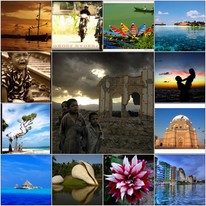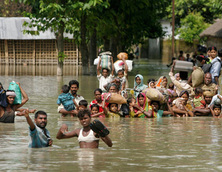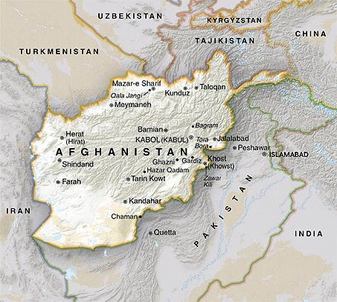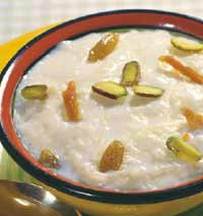South Asia!

There are a total of seven countries in South Asia, these countries are:
- India
- Pakistan
- Afghanistan
- Sri Lanka
- Nepal
- Bangladesh
- Bhutan
Major Physical Features in South Asia:

Mount Everest in the Himalaya's.
Many of the landforms in South Asia are the result of the huge tectonic forces that positioned the Indian subcontinent along the southern edge of the Eurasian continent. The Indian subcontinent and the area surrounding it have some of the most spectacular landforms on earth and have proven what can happen when two massive tectonic plates collide.
Indian-Australian Plate: About a 180 million years ago,the Indian-Australian plate, which contains India, broke free from the eastern edge of the African continent and drifted off to the northeast. About 60 million years ago it began to collide with the Eurasian Plate it turned India into a giant peninsula jutting into the Indian Ocean. As the relentless pushing between these two tectonic plates continued to occur, both the leading (northern) edge of India and the southern edge of Eurasia crumpled and buckled into what is now known as the highest mountain range in the world. The uplands of this region is not so densely populated due to the high degree of tectonic activity and deep crustal fractures. This causes South Asia to be prone to devastating earthquakes. Gujarat in western India in 2001 had a major earthquake that was a magnitude of 7.7, as well as another major earthquake with a magnitude of 7.6 that hit the India-Pakistan border in 2005.
Himalaya Mountains: This mountain range contains the worlds highest mountains. One of the well known mountains in the Himalayas is Mount Everest. A huge tourist area for sight seeing, as well as for the mountain climbers who are up for the biggest challenge a mountain climber could have. The Himalaya's rise more than 28,000 feet (8,500 meters)
Plateau of Tibet: The Plateau of Tibet, which rose up behind the Himalaya Mountain range, is at an elevation of more than 15,000 feet in some places.
Indo-Gangetic Plain: This feature is further south and southwest of the Himalaya's. The Indo-Gangetic Plain contains the Indus and Ganga river basins. The river valley's and coastal zones are densely occupied.
Deccan Plateau: This plateau consists of an area of modest uplands. It is 1,000 to 2,000 feet in elevation and interspersed with river valley's.
Eastern and Western Ghats: These are two moderately high mountain ranges that bounds the upland regions on the east and the west. These mountains descend to long but narrow coastlines interrupted by extensive river deltas and floodplains.
Indian-Australian Plate: About a 180 million years ago,the Indian-Australian plate, which contains India, broke free from the eastern edge of the African continent and drifted off to the northeast. About 60 million years ago it began to collide with the Eurasian Plate it turned India into a giant peninsula jutting into the Indian Ocean. As the relentless pushing between these two tectonic plates continued to occur, both the leading (northern) edge of India and the southern edge of Eurasia crumpled and buckled into what is now known as the highest mountain range in the world. The uplands of this region is not so densely populated due to the high degree of tectonic activity and deep crustal fractures. This causes South Asia to be prone to devastating earthquakes. Gujarat in western India in 2001 had a major earthquake that was a magnitude of 7.7, as well as another major earthquake with a magnitude of 7.6 that hit the India-Pakistan border in 2005.
Himalaya Mountains: This mountain range contains the worlds highest mountains. One of the well known mountains in the Himalayas is Mount Everest. A huge tourist area for sight seeing, as well as for the mountain climbers who are up for the biggest challenge a mountain climber could have. The Himalaya's rise more than 28,000 feet (8,500 meters)
Plateau of Tibet: The Plateau of Tibet, which rose up behind the Himalaya Mountain range, is at an elevation of more than 15,000 feet in some places.
Indo-Gangetic Plain: This feature is further south and southwest of the Himalaya's. The Indo-Gangetic Plain contains the Indus and Ganga river basins. The river valley's and coastal zones are densely occupied.
Deccan Plateau: This plateau consists of an area of modest uplands. It is 1,000 to 2,000 feet in elevation and interspersed with river valley's.
Eastern and Western Ghats: These are two moderately high mountain ranges that bounds the upland regions on the east and the west. These mountains descend to long but narrow coastlines interrupted by extensive river deltas and floodplains.
Climate in South Asia:

Monsoon in India.
There is a major contrast between summer and winter in the subcontinent of South Asia, and the main cause of the contrast is the switch in wind patters in the two major seasons. "The impacts result not only from gradual changes in temperature and sea
level but also, in particular, from increased climate variability and
extremes, including more intense floods, droughts, and storms."
(Source: Managing Climate Risk: Integrating Adaptation into World Bank Group Operations)
Winter is usually referred to as the "Dry season" in South Asia. Winter is from about November to April/May. In the lowlands of eastern India and Bangladesh temperatures can be over a hundred degrees just in the shade alone. The roads become very dry and sandy, and tornadoes wreak havoc, killings hundreds of people and flattening many of their villages. This is a time of drought and starvation is in excess now because of it. In November the cooling Eurasian landmass sends cooler drier air over South Asia. In the winter season the Monsoon drops moisture over the Himalaya's which is mostly in the form of ice and snow. The melt water feeds the headwaters of the three river systems that figure prominently in the region: the Indus, the Ganga, and the Brahmaputra.
Summer is the other major season in Southern Asia, this ranges from mid-June to about the end of October. This can be referred to as "the time of the river" because the rivers are very full and bursting with water. The rains are excessive and feel never ending. There is major flooding in many of the villages because of the relentless rain, forcing villages to become tiny islands that most likely become cut off from civilization for almost three months out of the year. This summer rainy season is caused by warm, moisture-laden air flows coming off from the Indian Ocean over the Indian subcontinent. The abundance of this rainfall is amplified by the inter-tropical convergence zone (ITCZ), where air masses moving south from the Northern Hemisphere converge near the equator and produce a lot of precipitation because of the constant rising and cooling of the moisture. This rainy season is referred to as a Monsoon.
(Source: Managing Climate Risk: Integrating Adaptation into World Bank Group Operations)
Winter is usually referred to as the "Dry season" in South Asia. Winter is from about November to April/May. In the lowlands of eastern India and Bangladesh temperatures can be over a hundred degrees just in the shade alone. The roads become very dry and sandy, and tornadoes wreak havoc, killings hundreds of people and flattening many of their villages. This is a time of drought and starvation is in excess now because of it. In November the cooling Eurasian landmass sends cooler drier air over South Asia. In the winter season the Monsoon drops moisture over the Himalaya's which is mostly in the form of ice and snow. The melt water feeds the headwaters of the three river systems that figure prominently in the region: the Indus, the Ganga, and the Brahmaputra.
Summer is the other major season in Southern Asia, this ranges from mid-June to about the end of October. This can be referred to as "the time of the river" because the rivers are very full and bursting with water. The rains are excessive and feel never ending. There is major flooding in many of the villages because of the relentless rain, forcing villages to become tiny islands that most likely become cut off from civilization for almost three months out of the year. This summer rainy season is caused by warm, moisture-laden air flows coming off from the Indian Ocean over the Indian subcontinent. The abundance of this rainfall is amplified by the inter-tropical convergence zone (ITCZ), where air masses moving south from the Northern Hemisphere converge near the equator and produce a lot of precipitation because of the constant rising and cooling of the moisture. This rainy season is referred to as a Monsoon.
Resources:
- Iron Ore
- Bauxite
- Coal
- Lumber
- Copper
- Salt
Religions:

Hinduism is practiced by approximately 900 milliion people. 800 of those people of which live in India.
Some of the other religions that are practiced here in South Asia are those such as: Buddhism, Sikkhism, Jainism, Parsis, Christianity, and a very small amount of Jews.
Sikhism was founded in the fifteenth century by Guru Nanak as a challenge to contemporary socioreligious systems, but the new religious philosophy was inspired by both Hindu and Islamic ideals.
Jainism, like Buddhism originated as reformist movement within Hinduism more than two-thousand years ago. Janis (about 6 million people) are founded mainly in western India.
Parsis, though few in number are a highly visible minority in India’s western cities, where they have distinguished themselves in business and finance, politics, and the arts.
Some of the other religions that are practiced here in South Asia are those such as: Buddhism, Sikkhism, Jainism, Parsis, Christianity, and a very small amount of Jews.
Sikhism was founded in the fifteenth century by Guru Nanak as a challenge to contemporary socioreligious systems, but the new religious philosophy was inspired by both Hindu and Islamic ideals.
Jainism, like Buddhism originated as reformist movement within Hinduism more than two-thousand years ago. Janis (about 6 million people) are founded mainly in western India.
Parsis, though few in number are a highly visible minority in India’s western cities, where they have distinguished themselves in business and finance, politics, and the arts.
Industry over Agriculture:
After gaining independence from Britain in 1947, South Asia's new leaders favored industrial development over agriculture. They believed that government involvement in industrialization was necessary to ensure the levels of job creation that would cure poverty. Another goal that they also had was to reduce the need to import manufactured goods from the industrialized world.
For the most part South Asian industrial policies failed to meet their goal expectations. The emphasis of self-sufficiency in industry was ill suited to countries that had been primarily agricultural for years.
In India, governments invested a huge amount of money in a relatively small industrial sector that even today only employs 12 percent of the population, where as 60 percent are employed in agriculture.
For the most part South Asian industrial policies failed to meet their goal expectations. The emphasis of self-sufficiency in industry was ill suited to countries that had been primarily agricultural for years.
In India, governments invested a huge amount of money in a relatively small industrial sector that even today only employs 12 percent of the population, where as 60 percent are employed in agriculture.
Afghanistan:

The Hindu Kush and the Pamir Mountains are steep sided in the north side of Afghanistan. These mountains extend west, than fan out into lower mountains and hill, and eventually into plains to the north, west, and south. The landscapes here are still very arid. Afghanistan has sparsely vegetated meadows and pastureland, but most of the people struggle to earn a subsistence living from cultivation and the keeping of grazing animals.
Main food crops here consist of: wheat, fruit, and nuts. Opium poppies are native to this region, but they were not an important cash crop.
Life expectancy here is about 42 years, and the population is growing by 2.6 percent per year, by women bearing more than six children on average. Literacy rates here in Afghanistan are among the lowest on earth and are increasing only very slowly. Only 21 percent of women and 51 percent of men over age 15 can read. There is about 30 million Afghans, as of 2005.
Main food crops here consist of: wheat, fruit, and nuts. Opium poppies are native to this region, but they were not an important cash crop.
Life expectancy here is about 42 years, and the population is growing by 2.6 percent per year, by women bearing more than six children on average. Literacy rates here in Afghanistan are among the lowest on earth and are increasing only very slowly. Only 21 percent of women and 51 percent of men over age 15 can read. There is about 30 million Afghans, as of 2005.
Cuisine:

Kheer dessert!
Na an, a type of flat bread from the former regions is a common part of meals to be had in many parts of South as well as Southwest Asia. Other staples of many of the cuisines include rice, chapati made from wheat and barley, and beans.
Foods in this area of the world are flavored with various types of chili, black pepper, cloves, and other strong herbs and spices along with the flavored butter Ghee. Ginger is an ingredient that can be used in both savory and sweet recipes in south Asian cuisine. Chopped ginger is fried with meat and pickled ginger is often an accompaniment to boiled rice. Ginger juice and ginger boiled in syrup are used to make desserts. Tumeric, and cumin are often used to make curries.
Common meats include lamb, goat and chicken. Beef is less common than in western cuisines because cattle have a special place in Hinduism. Prohibitions against beef extend to the meat of (water) buffalo and yaks to some extent. Pork is considered as a by all Muslims and is avoided by most Hindus. A variety of very sweet deserts which use dairy products are also found in South Asian cuisines. The main ingredients to south Asian desserts are reduced milk, ground almonds, lentil flour, Ghee and sugar. Kheer is a dairy based rice pudding, a popular and common dessert.
Foods in this area of the world are flavored with various types of chili, black pepper, cloves, and other strong herbs and spices along with the flavored butter Ghee. Ginger is an ingredient that can be used in both savory and sweet recipes in south Asian cuisine. Chopped ginger is fried with meat and pickled ginger is often an accompaniment to boiled rice. Ginger juice and ginger boiled in syrup are used to make desserts. Tumeric, and cumin are often used to make curries.
Common meats include lamb, goat and chicken. Beef is less common than in western cuisines because cattle have a special place in Hinduism. Prohibitions against beef extend to the meat of (water) buffalo and yaks to some extent. Pork is considered as a by all Muslims and is avoided by most Hindus. A variety of very sweet deserts which use dairy products are also found in South Asian cuisines. The main ingredients to south Asian desserts are reduced milk, ground almonds, lentil flour, Ghee and sugar. Kheer is a dairy based rice pudding, a popular and common dessert.
References:
Map from: http://3.bp.blogspot.com/_G5ORyLfzo3U/TTjsdLKFoEI/AAAAAAAAABM/2e3iTxo7Ge0/s1600/South_asia.jpg
Photo of Monsoon from: http://www.rodhandeland.com/FreshWater/World/2d%20Monsoon%20Flooding.jpg
Climate information extras retrieved from: Managing Climate Risk: Integrating Adaptation into World Bank Group Operations,http://web.worldbank.org/WBSITE/EXTERNAL/COUNTRIES/SOUTHASIAEXT/0,,contentMDK:21469804~menuPK:2246552~pagePK:2865106~piPK:2865128~theSitePK:223547,00.html.
Afghanistan picture from: http://2.bp.blogspot.com/_-Ha6trsD6k0/TREvBO9mHOI/AAAAAAAACeA/cKmgDUPJiEw/s1600/AfghanistanMap01.jpg
religion picture from: http://asiasociety.org/files/buddha.jpg
Kheer photo from: http://www.eachin1.com/wp-content/uploads/2011/02/kheer.jpg
Photo of Monsoon from: http://www.rodhandeland.com/FreshWater/World/2d%20Monsoon%20Flooding.jpg
Climate information extras retrieved from: Managing Climate Risk: Integrating Adaptation into World Bank Group Operations,http://web.worldbank.org/WBSITE/EXTERNAL/COUNTRIES/SOUTHASIAEXT/0,,contentMDK:21469804~menuPK:2246552~pagePK:2865106~piPK:2865128~theSitePK:223547,00.html.
Afghanistan picture from: http://2.bp.blogspot.com/_-Ha6trsD6k0/TREvBO9mHOI/AAAAAAAACeA/cKmgDUPJiEw/s1600/AfghanistanMap01.jpg
religion picture from: http://asiasociety.org/files/buddha.jpg
Kheer photo from: http://www.eachin1.com/wp-content/uploads/2011/02/kheer.jpg
